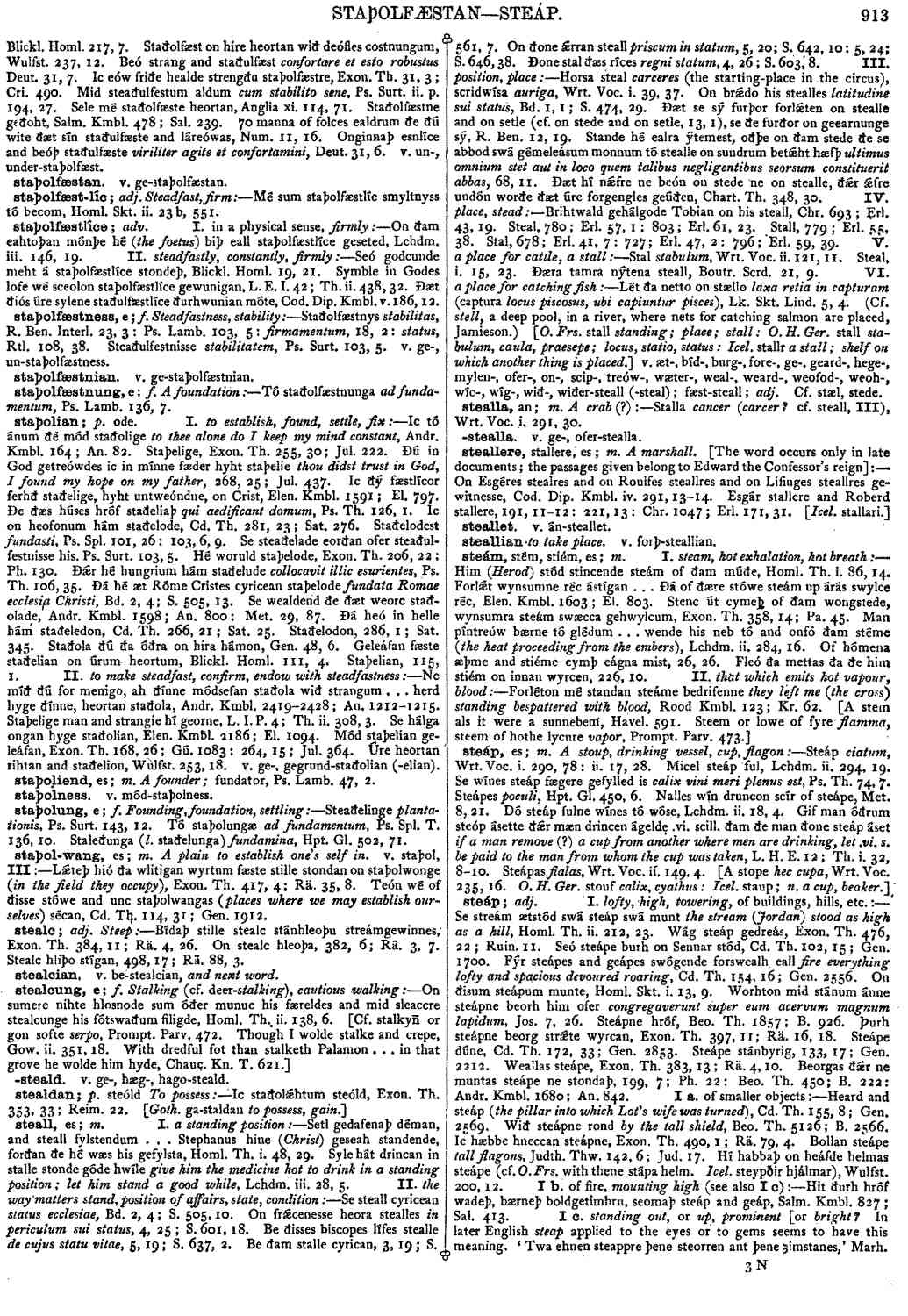steáp
- adjective
-
Se streám ætstód swá steáp swá munt
the stream (Jordan) stood as high as a hill,
- Homl. Th. ii. 212, 23.
-
Wág steáp gedreás,
- Exon. Th. 476, 22; Ruin. 11.
-
Seó steápe burh on Sennar stód,
- Cd. Th. 102, 15; Gen. 1700.
-
Fýr steápes and geápes swógende forswealh eall
fire everything lofty and spacious devoured roaring,
- Cd. Th. 154, 16; Gen. 2556.
-
On ðisum steápum munte,
- Homl. Skt. i. 13, 9.
-
Worhton mid stánum ánne steápne beorh him ofer
congregaverunt super eum acervum magnum lapidum,
- Jos. 7, 26.
-
Steápne hróf,
- Beo. Th. 1857; B. 926.
-
Þurh steápne beorg strǽte wyrcan,
- Exon. Th. 397, 11; Rä. 16, 18.
-
Steápe dúne,
- Cd. Th. 172, 33; Gen. 2853.
-
Steápe stánbyrig,
- 133, 17; Gen. 2212.
-
Weallas steápe,
- Exon. Th. 383, 13; Rä. 4, 10.
-
Beorgas ðǽr ne muntas steápe ne stondeþ, 199, 7; Ph. 22: Beo. Th. 450; B. 222: Andr. Kmbl. 1680; An. 842. I a. of smaller objects :-- Heard and steáp (
the pillar into which Lot's wife was turned
),- Cd. Th. 155, 8; Gen. 2569.
-
Wið steápne rond
by the tall shield,
- Beo. Th. 5126; B. 2566.
-
Ic hæbbe hneccan steápne,
- Exon. Th. 490, 1; Rä. 79, 4.
-
Bollan steápe
tall flagons,
- Judth. Thw. 142, 6; Jud. 17.
-
Hí habbaþ on heáfde helmas steápe (cf. O. Frs. with thene stápa helm. Icel. steypðir hjálmar), Wulfst. 200, 12. I b. of fire, mounting high (see also I c) :-- Hit ðurh hróf wadeþ, bærneþ boldgetimbru, seomaþ steáp and geáp, Salm. Kmbl. 827; Sal. 413. I c. standing out, or up, prominent [or bright? In later English
steap
applied to the eyes or to gems seems to have this meaning. 'Twa ehnen steappre þene steorren an þene ȝimstanes'- Marh.9, 4.
-
In the note on this passage Cockayne gives other instances of this use, e.g. Schinende and schenre þen eni ȝimstanes, steapre þen is steorre. In Chaucer's line, Prol. 201, the meaning might be
prominent. In the passage quoted below from Ælfric the Latin from which the description is taken has oculi grandes. ]
Gim sceal on hringe standan steáp and geáp,- Menol. Fox 505; Gn. C. 23.
-
Se steápa gim,
- Salm. Kmbl. 570; Sal. 284.
-
Hé hæfþ steápe eágan,
- Homl. Th. i. 456, 17.
-
Óð ða steápan heofenan
to high heaven,
- Homl. Th. i. 3, 500.
Bosworth, Joseph. “steáp.” In An Anglo-Saxon Dictionary Online, edited by Thomas Northcote Toller, Christ Sean, and Ondřej Tichy. Prague: Faculty of Arts, Charles University, 2014. https://bosworthtoller.com/28818.
Checked: 0